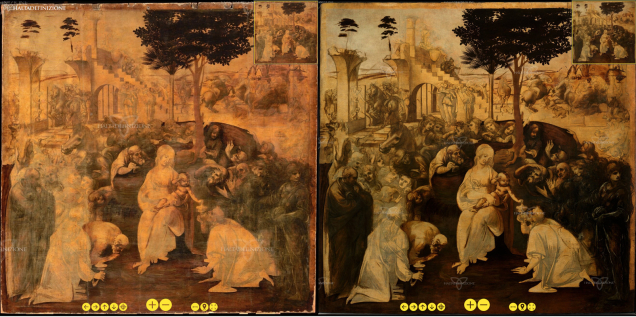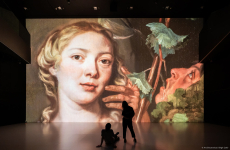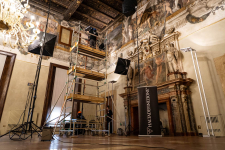The Corriere della Sera newspaper has published an article about the two sets of digital images that were made of this masterwork.
The Adoration of the Magi is one of Leonardo’s most significant works. Begun around 1481, Leonardo left it incomplete when he went to Milano to work at the court of Ludovico il Moro. Its unfinished state allows us today to research and understand Leonardo’s composition and design technique. The painting is simply sketched out in some places with some characters barely drawn, others more finished, while others still are drawn out just to the first layer of paint. As it is unfinished, the Adoration is a key work to understanding all of Leonardo’s painting.
With the authorization of the government’s Special Superintendent for Historical, Artistic and Human Heritage and of the Association of Museums of Florence, Haltadefinizione has performed two digital captures of this precious masterpiece. The first was done in 2013, before the restoration, which was directed by Marco Ciatti and Cecilia Frosinini of the “Opificio delle Pietre Dure” or Workshop of Precious Stones (one of Italy’s two principal art restoration agencies). Their careful work took five years to fix its structure and the changes that had been made to the picture surface.
In 2017, Haltadefinizione was back at the Uffizi Galleries for the second digital capture. This time, Haltadefinizione worked with its partner Memooria for a 2+3D capture method of ultra-high definition images. The addition of 3D revealed every detail of the restoration and the material substance of the work.
Now, thanks to an exclusive viewer available to readers of the Corriere della Sera, we can see this masterpiece as never before, and explore it both before and after restoration, zooming in on one point in both image sets to compare the two at the same time, without any loss of image quality.
Ultra-high definition digital images let the viewer be fully immersed in a painting, which is a whole new way to look at great works of art.
Read the article
Discover the viewer



